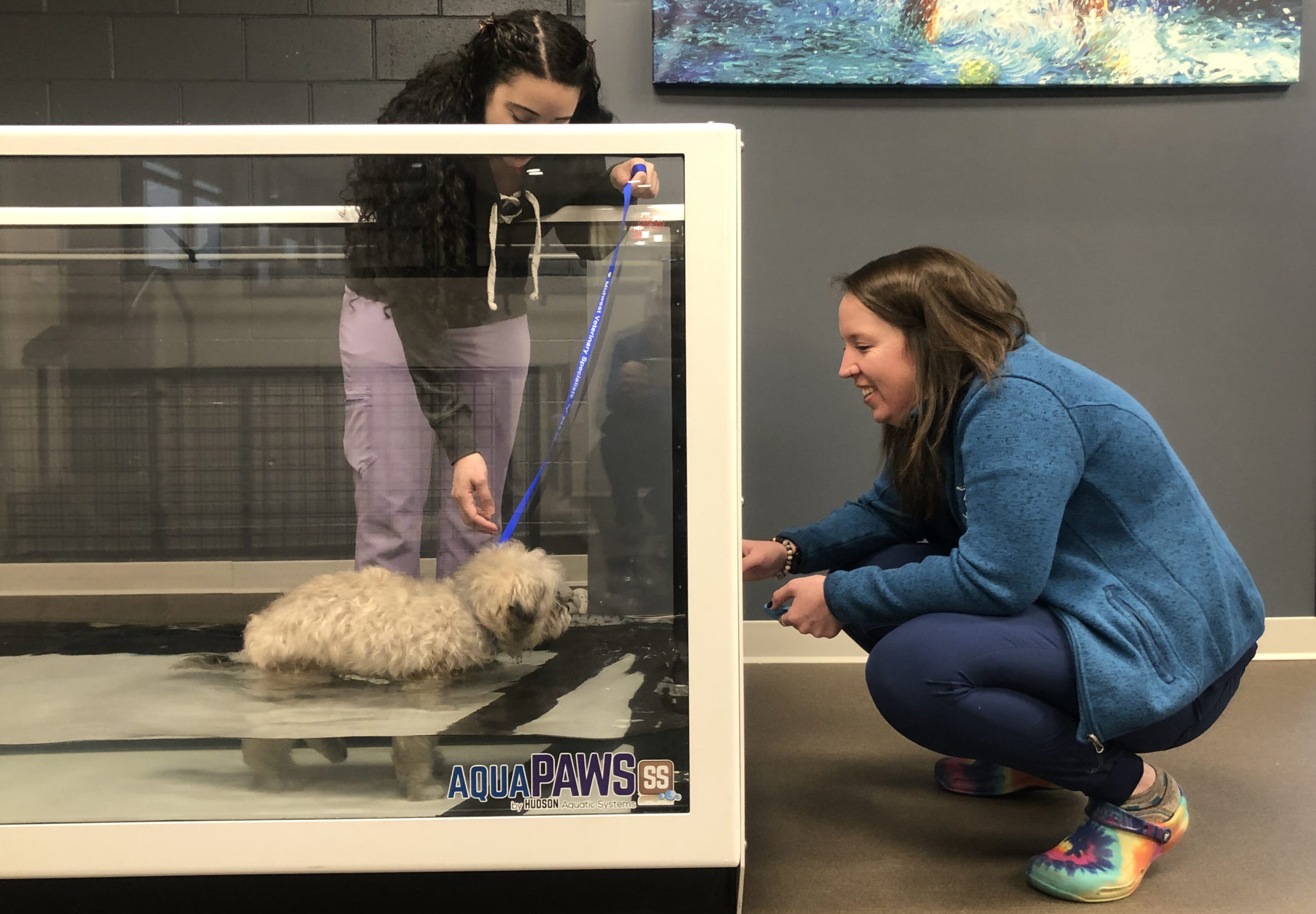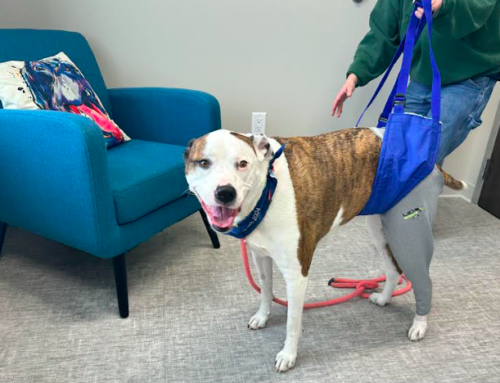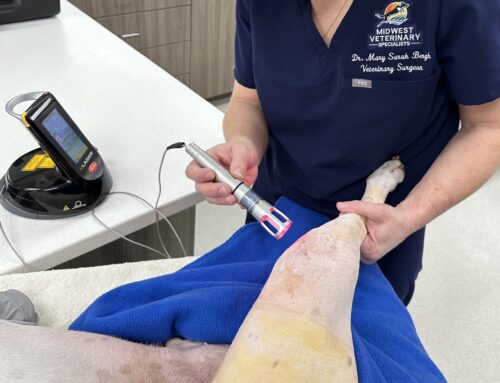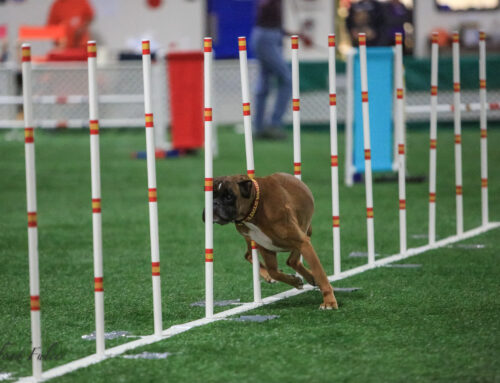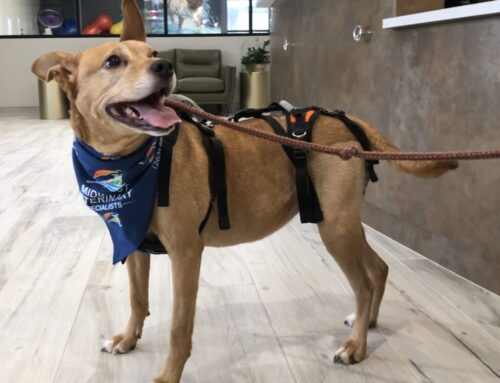Combining physical rehabilitation with medical and surgical care is beneficial for many dogs to help restore mobility and musculoskeletal function. Our Midwest Veterinary Specialists team wants to provide information about conditions that best respond to rehabilitation therapy, so you know what to expect if your dog is affected.
#1: Cranial cruciate ligament rupture in dogs
Cranial cruciate ligament (CCL) rupture is one of the most common reasons dogs experience hind limb lameness, which can be the result of a traumatic injury, but is most commonly caused by chronic ligament degeneration. Surgery is the best approach to restore knee stability after a CCL rupture, and to help decrease arthritis in the joint. Factors you should know about CCL rupture include:
- Dogs at risk — Any dog can experience a CCL rupture, but dogs at increased risk include Labrador retrievers, golden retrievers, rottweilers, Newfoundlands, and Saint Bernards. The condition has also been associated with small-breed dogs affected by medial luxating patellas.
- Rehabilitation exercises — After surgery, rehabilitation initially involves massage and passage range of motion (ROM) exercises. As the dog recovers, weight shifting exercises and underwater treadmill walking are helpful, followed by leash walking on hills, jogging, and trotting.
#2: Femoral head and neck ostectomy in dogs
A femoral head and neck ostectomy addresses conditions such as avascular femoral head necrosis, hip luxation, and femoral head and neck fracture. Factors you should know about femoral head and neck ostectomy in dogs include:
- Dogs at risk — Small dogs, such as Chihuahuas, bichon frises, poodles, and Pomeranians, are at increased risk for avascular femoral head necrosis.
- Rehabilitation exercises — Early therapy involves massage and gentle, passive ROM exercises. After the skin incision heals, underwater treadmill sessions help promote partial weight bearing to help the dog return to their normal gait. As healing continues, balance boards, exercise balls, and other tools can help improve weight bearing and strengthen the core.
#3: Intervertebral disc disease in dogs
Degenerative changes to the dog’s intervertebral disc can cause disc material to impinge on the spinal cord, leading to significant pain and mobility issues. A neurological examination and advanced imaging techniques are required to determine the lesion location. In mild cases, dogs can be treated conservatively with strict confinement and anti-inflammatory medications but, in more severe cases, surgery is needed to remove the disc material and relieve the pressure on the spinal cord. All affected dogs can benefit from rehabilitation exercises. Factors you should know about intervertebral disc disease (IVDD) in dogs include:
- Dogs at risk — IVDD Type I most commonly affects young to middle aged chondrodystrophoid dogs, such as dachshunds, Pekingese, beagles, and Lhasa apsos. IVDD Type II most commonly affects senior large-breed dogs, such as German shepherds and Labrador retrievers.
- Rehabilitation exercises — Specific therapy depends on the dog’s condition, but massage, passive ROM, targeted exercises using an exercise ball, and water therapy are frequently used. Water therapy is especially helpful for dogs with severe paresis or paralysis, because the water’s buoyancy strengthens the dog’s mobility, and allows the dog to move in the water before they can walk on land. For dogs who can walk without support, exercises, such as stepping over rails, can help improve their coordination.
#4: Osteoarthritis in dogs
Osteoarthritis (OA) is a chronic joint disease in dogs characterized by joint cartilage degeneration, joint capsule thickening, and new bone formation around the joint that leads to pain and decreased mobility. OA typically occurs secondary to orthopedic diseases, such as CCL rupture, hip dysplasia, elbow dysplasia, and osteochondritis dissecans. Other contributing factors include body weight, neuter or spay status, activity level, and diet. Factors you should know about OA in dogs include:
- Dogs at risk — Any dog can be affected by OA, but older, large-breed dogs, such as German shepherds, rottweilers, doberman pinschers, and Great Danes, are at increased risk.
- Rehabilitation exercises — Underwater treadmill sessions are helpful to build muscle strength and endurance while minimizing impact on painful joints. Targeted weight bearing exercises are also helpful to strengthen joints.
#5: Obesity in dogs

According to the Association for Pet Obesity Prevention (APOP), 55.8% of dogs are classified as clinically overweight or obese by their veterinary healthcare professional. This is problematic, because overweight dogs are at increased risk for significant health complications, such as cancer, diabetes, kidney failure, and arthritis. When addressing obesity in dogs, the diet is often the focus, but scheduled exercise sessions can help facilitate healthy weight loss. Factors you should know about obesity in dogs include:
- Dogs at risk — Any dog can be affected by obesity, but those at increased risk include middle-aged dogs, spayed or neutered dogs, and dogs who have a metabolic condition.
- Rehabilitation exercises — Scheduled exercise sessions can help burn calories and build muscle mass, and a specific program should be customized for each dog.
Rehabilitation can significantly facilitate recovery for dogs experiencing many conditions. If you think rehabilitation could benefit your dog, contact our Midwest Veterinary Specialists team, and we will devise a program that fits your dog’s needs.


